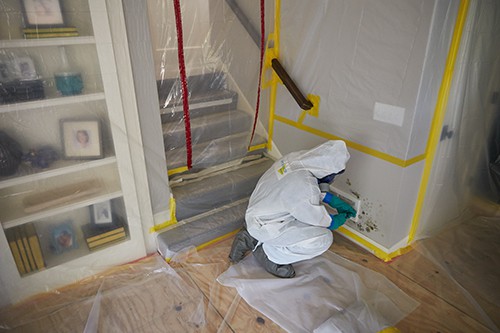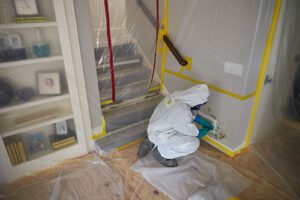Mold Testing Methods

Many Mold Testing Colorado Springs methods are able to detect the presence of mold spores, but not all can identify the specific types. It is important to understand that the spore count in any given area can change significantly over time and from location to location.
Your mold inspector will first conduct a non-intrusive visual inspection. If they can confirm mold growth, they will take samples using swabs, tape lifts, and bulk samples.
Air sampling is useful in determining the types and quantities of mold spores present in a particular area. It can be used with other methods of testing, such as swabbing and bulk, or as a stand-alone test. An air sample is collected by running an impactor device that draws in the ambient air and impacts it on a sticky surface, trapping the mold spores. Samples are then analyzed using either a sporimeter or culture analysis by an accredited laboratory.
The advantage of an air sample is that it provides a snapshot estimate for a particular location at a given point in time. However, it is important to remember that it is only a snapshot and that the amount of mold spores may change over time. Additionally, a spore trap is only able to capture the mold spores that have drifted into the collection area and does not provide information about the number of spores in the general environment.
Tape samples are the best way to determine the type and quantity of mold growth, but they are often not practical due to the need for a destructive test (cutting up floor, wall, or carpet segments). A tape lift can also be useful for identifying the species of a suspect mold through direct microscopy, although it is important to note that light-colored and highly airborne genera such as Aspergillus and Penicillium are difficult to detect with a tape sample.
A spore trap can be useful in determining the types of mold spores present in sporadic locations or in comparing spore levels between two different areas. Spore traps are also able to provide a list of the most commonly found genera in a sample. However, they do not provide any indication of the relative potency of a genus or its allergenic potential.
An alternative to a spore trap is an ERMI test, which uses DNA to identify 36 different genera in a dust sample. This test is typically less expensive than a spore test but still requires an analyst at a lab for results. If you choose to use an ERMI test, it is essential that the sample kit include the supplies needed to collect a sufficient number of samples for a thorough evaluation.
Surface Sampling
If you suspect mold is present on a specific surface, such as a wall, floor, or piece of equipment, surface sampling is often the best option. A specialized sampler is used to collect a small amount of material from the suspected area and submit it for laboratory testing. This is also known as “qualitative surface sampling.”
Qualitative sampling can reveal whether or not discoloration is caused by fungal growth, identify visible fungi, and identify the types of spores found in settled dust. This information is useful for the control and maintenance of cleanroom environments like hospitals, manufacturing plants, biotech laboratories, etc.
Unfortunately, it is difficult to determine if airborne levels of specific molds pose a health hazard for home and business occupants. No standards or threshold limit values (TLVs) for mold spores have been established at this time, and individual susceptibility to the effects of exposures varies greatly.
Some testing methods can identify a portion of the living molds in a sample by growing them in a laboratory, but these tests may miss or undercount those that are not live or won’t grow well on the nutrient medium that is used to incubate the samples. Nonliving spores are equally capable of causing allergies, and a single spore count does not necessarily indicate that the air is unhealthy to breathe.
Many home improvement stores sell a variety of inexpensive mold testing kits that include tape samples to lift swabs for submission, a test strip with two lines for Stachybotrys and Penicillium/Aspergillus similar to those in pregnancy tests, and a sample card for writing your address to send the samples to an AIHA-accredited lab for evaluation. One kit costs about $45 and includes the cost of laboratory analysis to detect all seven commonly tested molds.
Despite its limitations, surface sampling is the most effective and cost-efficient way to determine if a particular area needs attention. It is important to remember, however, that the presence of mold on a surface does not automatically require professional remediation. Efforts should be focused on finding and correcting the source of moisture and not relying solely on test results to confirm or deny the existence of a problem.
Specimen Sampling
Most mold testing methods can only detect living spores in the air or in settled dust; they cannot tell you which specific types of mold are present. Many home test kits include a tape lift or swab that can be sent to a lab for identification. The lab will usually identify the genus of mold but not its relative concentration.
Some tests can also detect whether a mold is toxin-producing, but not all can. Mycotoxins are substances that may harm living tissue if enough of them enter the body, such as through the nose or mouth during breathing. The full range of effects caused by mycotoxins is not yet fully understood, and they depend on individual susceptibility and the amount of mycotoxins encountered.
The Environmental Relative Moldiness Index (ERMI) uses DNA-based methods to observe levels of a small number of common molds in surface samples taken from homes and buildings. While it is not considered quantitative, ERMI provides a snapshot estimate of indoor mold spores and a comparison to outdoor air spores taken as a control.
Another popular method of air sampling is spore trap sampling, which pumps a known volume of air onto a petri dish coated with nutrient media. The sample will then be incubated to see if any of the spores grow. The spores that are grown on the slide are then counted and identified. This type of sampling can miss the presence of non-viable spores as well as spores that are not growing but can cause allergy symptoms.
All of the above methods of sampling require some type of specialized equipment that must be purchased and analyzed by a professional laboratory. These tests are typically included in a thorough visual mold inspection by a board-certified inspector. The complete inspection will begin with a multi-point exterior inspection looking for potential microbial growth and moisture, followed by a detailed visual inspection of the interior of the home or building. Then, based on the interview and the client’s concerns, a recommendation will be made for further testing.
Intrusive Sampling
Mold growth left unaddressed is an ongoing hazard to the integrity of a building’s structure and can also compromise the respiratory health of vulnerable occupants. Since mold spores can be spread from room to room by airborne means, home inspectors should consider offering mold testing as a part of their services in order to provide this valuable and potentially life-saving service.
Mold tests may be performed using one of several methods. Many of these techniques involve collecting a sample from the area in question and sending it to a laboratory for analysis. Sample types include the use of a standard bulk sample, which collects a bit of a suspect material for testing, as well as a tape lift and swab test.
Surface and bulk samples are analyzed using various methods, but most laboratory analysis involves examining the organisms that grow on the sampled material under a microscope for identification and counting the number of viable specimens. Some of the more advanced techniques, like DNA testing, can identify specific species through a process called culturing, where organisms are fed different nutrients and observed for how they grow. However, this type of testing is expensive and requires significant time to complete.
In general, it is best for a professional to perform intrusive sampling when possible, as this will usually result in the most accurate results. This will allow the inspector to evaluate a large surface area as well as look for hidden areas where mold could be hiding.
There are a wide variety of tests available for finding mold in the air, on surfaces, or in a bulk sample. These tests are all useful in their own way, but it is important to remember that a positive test result only tells you what types of molds were present at the time and location that the sample was taken.
While some types of mold are capable of producing mycotoxins, the full range of their toxic effects is not fully understood at this time. This is why it is important to avoid using at-home DIY test kits and instead hire a qualified professional who can interpret and explain the lab results.

